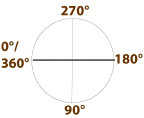Neptune lower squares Pluto near 2063. What does that mean for us who currently live? What can we learn from the other Neptune-Pluto lower squares? Expect complicated answers and long discussions since the possibilites point in many different directions.
One thing is certain, climate change will affect our lives for many years to come. Whatever we may do to reverse the current process, the direction of change already in motion puts us on a course for tremendous change that will affect on all of earth's populations.
The last three times Neptune stood at the lower square (90°) to Pluto were near 580, 1082 and 1567. At the first of these groups like the Lombards and Slavs began to overwhelm other peoples in Northern Italy and the Balkans, respectively. More importantly, the new population began to organize around traditions that personified their identity and way-of-like for years to come. Similar themes can be seen at the next two lower squares. It is significant that the Church called for Crusades starting in 1095; it had established itself to a degree that it felt confident enough to rouse people from many areas of Europe to a united cause. Near 1567 new modes of thought epitomized by, but not limited to Protestantnism, fought against a power regime at least thousand years old. In all three cases fundamental change was taking place, most consequences of which not obvious to the participants of the time. If the process holds true we can expect the same near 2063…
Another noticeable charactersitic of the lower square is that it must work within the theme of the overall cycle; fundamental change needs to have something fundamental to alter. So what are the themes that subject to change of direction? Certainly, human-induced climate change directly related to industrial output and an economic system jumps out immediately. Some others include the relationship between modern thought and older traditions. Additional issues deal with the loss of frontier, exploding population, rich countries versus poor ones and demographics that shift across age, natural and national boundaries. All of these may or may not be related, and at first their connection seems tenuous. Astute readers should expect a counter-arguement.
The Neptune-Pluto relationship, particularly the one that existed between 1398 and 1893 brings these all together, but that is not their only connection. Understanding the relationship of these more outer planets helps reveal why.
Between 1398 and 1893 in group thought processes shifted in a major way. All of them are tied to a fundamental shift that occurred during this period, one defined by the time between Neptune and Pluto aligned at the same latitudes. A simple synopsis reads like this: the uniting philosophy of Europe, Christianity, repositioned itself to answer a major change in demographics. This change allowed new forms of thought that created the potential to move away from a religiously based form of government and adherence.
I have struggled with that simplification for quite some time!
I understand any intuitive reaction that refuses to connect the ongoing issues with this synopsis, but further ponderance should reveal the connections.
Christianity dominated every facet of European life: government, economy, education, health, life and death. No one could, from commoner to king could proceed without Church approval. Many problems existed with this arrangement and everyone, which meant the entire European population knew it. An oversimplified response would cite the top-to-bottom corruption that permeated the institiution since that condition did exist. A deeper look would find that changing demographics lay deeper to the root of the cause. Simply, look at our present. No group would assume that one institution could regulate health, eduction, the economy, politics, inter- and intra-state commerce and spirituality. These days each one of life areas is complicated enough in their own separate spheres, but the Church had grown into the complete arbiter of all. The arguement thus becomes not why did a corrupt establishment eventually lose its complete influence, but whether or not it would have held that its power for longer time if it had cleansed itself. That arguement will be reserved for another entry.
This "theory", likely not my own, leads down a clear path. A corrupt Church inspired people to find alternatives. The only known ones came from classic Greece and Rome. While those texts answered some questions, others that these could not answer raised curiousity and further questions. The Church's objections only raised resolve and gave people courage to completely question the establshment's validity. Eventually, matters reached a tipping point, further pondering raised issues defenders of the faith could not answer and secular thought, a faint dream from the Axial Age, soon took its place next to religious dogma.
So how does this development connect to what we can expect near 2063? In many pertinent ways!




